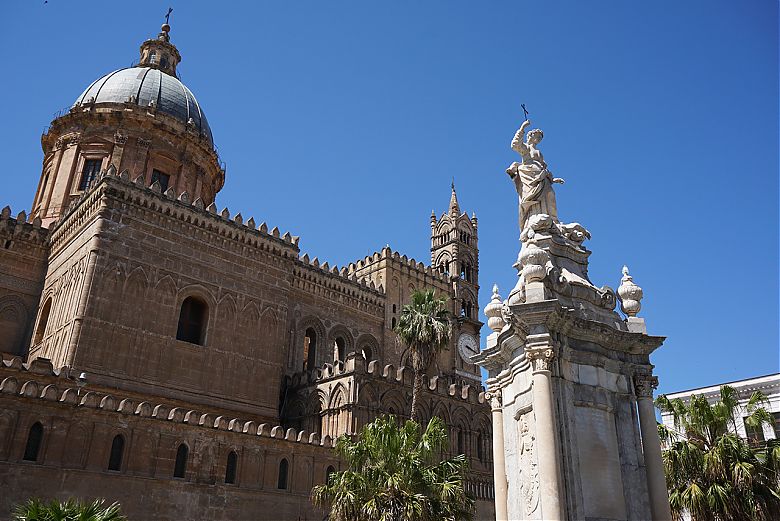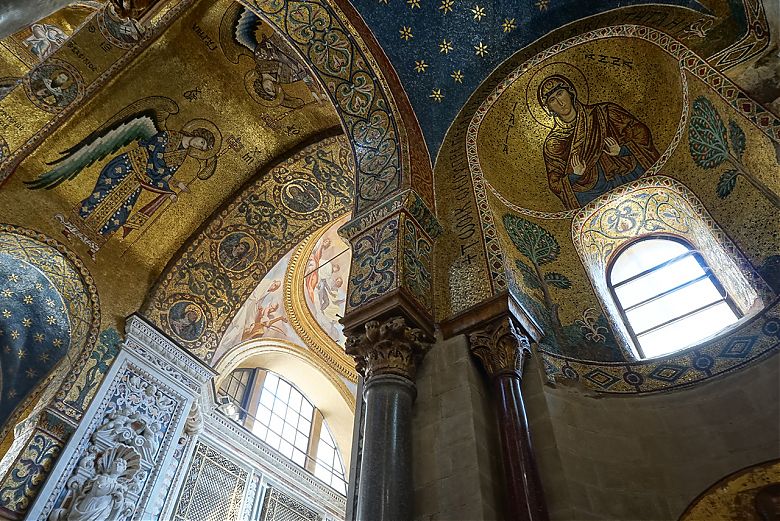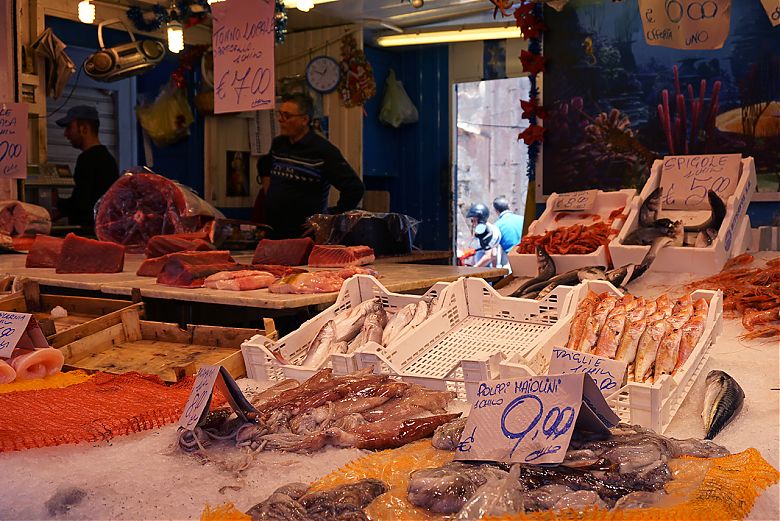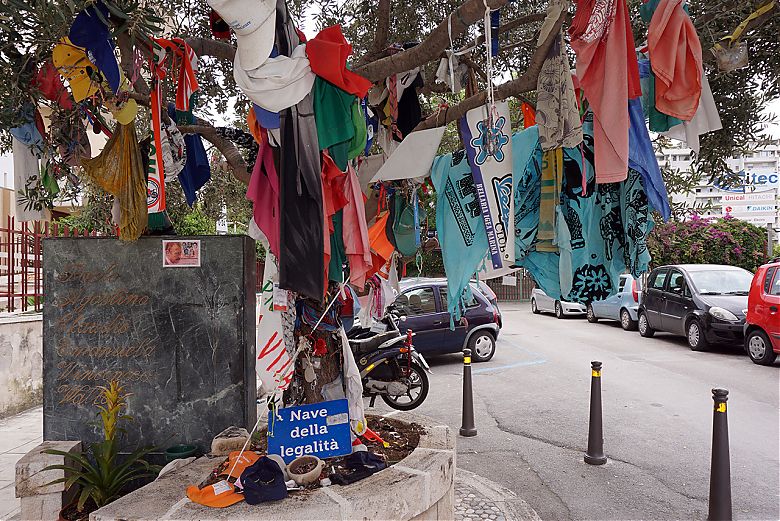2 days in Palermo – What to see in the Sicilian capital?

Aided by a good offer, I popped in Palermo and surroundings (Cefalù, Trapani and Erice, but I will talk about further!).
I've been lucky, why were the last days (between late May and early June) before the arrival of an oppressive heat on the peninsula, and I assure you that visit Sicily with 35 ° and high humidity, It is something I would not wish even to my worst enemy. 🙂
The city of Palermo, “second” capital Kingdom of the Two Sicilies after Naples, He is experiencing, just as the latter, a phase “rebirth”, with associations which work on the territory, redevelopment e is sparse, recovery of degraded areas (come la Vuccirìa, which plays the dual role of the market and, in the weekend, nightlife center of Palermo).
some, He suffers from deficiencies in terms of street sweeping and public transport (especially in recent times) and, with 1.3 million tourists, It not yet has been able to enter fully into the “Grand Tour” tourism in Italy, but it has a artistic heritage of the highest level, yet to be discovered.
A mix of dominations probably unique in Italy (Norman, car), It meant that we were allowed to beautiful testimonies, in the rest of Italy, it is impossible to find, or almost.
We want to talk about Church of San Cataldo? of Martorana? The Byzantine Palatine Chapel? IL Cathedral of Monreale? About the same Cathedral of Palermo? It seems to go from Andalusia to North Africa, from Russia to the Middle East… all in walking distance. 🙂
It's not something that can be found in Naples, Rome or Florence, nor further north (perhaps, excluding Ravenna, and some other isolated case, where the Byzantine art and / or Arab has got to spread).
After doing indigestion churches, I did not fail to visit “Norman Palace“, home of’Sicilian Regional Assembly, building used since the times of the Arabs, taking advantage of the exposure, in those days, of a series of pictures of Botero, related to the theme of the Via Crucis.
How Not to mention, then, of Palermo markets, like that of Ballarò, of Chief, or Vuccirìa (“shouting”, dialect, because of the cries of auctioneers), where to try the famous street food Palermo… I loved the sandwich with fritters and croquettes, fried delight from the cost of 1 euro!
The same goes for arancini, that they are not too different from those to which we are customary in Naples, except that… are infinitely greater and anointed. 🙂
Special mention for the cannolo of the’Ancient kiosk Mondello, freshly prepared… nothing to do with the cannoli found in bakeries on the continent (including those which arrive on the day after, by ferry, or by air)!
To go back a bit’ more serious, before continuing on to the old village Mondello (the beach of Palermo) I decided to pay homage to the memory of two Italian heroes of the twentieth century: Giovanni Falcone and Paolo Borsellino.
I remember well, despite being a child, both their murder, both their funeral: in Naples there was a terrible heat, and I stayed with the family in silence, nailed to the TV, to follow the events. A few weeks that have forever changed Italy (for the worse or for the better, It depends on the points of view).
Present Day, in Palermo, They were planted two trees, due trees “legality”, planted outside the home of Falcone (in Via Notarbartolo), It is the place where the bomb exploded that killed Borsellino, in Via d'Amelio, outside his mother's house.
Certainly the word “legality” stark contrast with illegal parking in Via d'Amelio, and the lady who asks “If the machine finds himself”, and he replies that “due euro, please”, but I realize that I expect too much.
The only means of public transport in the city, at least until the opening of the tram or the elusive MAL, It is the coach.
I do not recommend relying on frequency table, which is located in the site of’AMAT, transport company Palermo, because it happens that the bus jump racing, or who does not arrive on time. In compenso, advice to arm themselves… good patience, waiting for the bus steps, and a map, seen that some poles are indicated as “abolished”, while in reality they are not, and some lines are indicated with one number, without indicating the path. 🙂
I made sure to spend the day visiting all points of interest nearby places, so I can move only on foot. The day after, Instead, I bought a day ticket AMAT, costing 3.5EUR, and I visited some places’ furthest (Monreale, Mondello, trees legality, etc.…)
The photos of my trip to Palermo are, Usual, in my gallery, A this address.
We route, in textual form, I followed in my visit to Palermo (and Monreale):
1DAY (arrival early morning) (pins verdi)
- Exit the airport, turn immediately right, and there buy a ticket for the bus Prestia&Comandè, Direct to the main station of Palermo
- Market Vucciria (with Ballarò and Capo, It is the most famous market of Palermo, and it is located in the District of Castellammare. The name originates from the French "boucherie", butcher's shop, because initially there was selling meat, while now it sells the fish. It takes place every morning, except Sundays. Vuccirìa means "confusion", that in a market of this type is foreseeable! Fin dal XII sec., here were many artisans' workshops. In the evening it is one of the centers of nightlife. There is a lot of food from street, such as the fritters or croquettes)
- Piazza Pretoria (and fountain Pretoria) (Situated at the crossroads between Via Maqueda and Corso Vitt.Emanuele, also called the Cassuto, It is in the city center. At its center there is a fountain, In origin, in 1573, He had to go in the Palace of St. Clement in Florence, and then it was bought by the Senate of Palermo. Because of the nudity of the statues, It is also called the "Fountain of Shame".)
- Piazza Vigliena (Four songs) (The "four corners" are the architectural perspectives of beginning '600, surrounding the square. Among the statues that decorate them, we also find Charles V and Philip IV of Spain. Each building looks towards a direction and a commandment, and Re represents a, one of the saints of Palermo, and a season)
- Church of San Cataldo (Arab-Christian church of the twelfth century., placed in piazza Bellini. It belongs to the Order of the Knights of the Holy Sepulchre, “heirs” Templar, and the red cross of the Templars is clearly visible several times inside.)
- St. Mary's (Church of Martorana) (Church of the Byzantine Rite, which dates from the twelfth century. They were Albanians, escaped from the persecution of the Turks, to bring the Byzantine Rite in Palermo. The cycle of mosaics located inside the church is the oldest in all of Sicily and represent Christ with the four archangels and patriarchs, while in the niches they are hosted the four evangelists, and sometimes remaining apostles)
- Via Ballarò (Ballaro Market) (known market town, bounded on the South by the bastions of Porta S.Agata Corso Tukory, and North Square Professed House, where there is the Church of Jesus. It is characterized by the vegetables and fruits that come from the hinterland. Mainly done weekdays from 9 all 13)
- Church of Jesus (In the square Piazza Professed House, It is one of the main Baroque churches of Palermo, and it was built by the Jesuits)
- Metropolitan Cathedral of the Blessed Virgin Mary of the Assumption (Open weekdays from 9 all 17:30 and until 19 public holidays. Free admission, except for the crypt, tombs and roofs, with variable cost among the 2 and of 7 EUR. In the right aisle there are the tombs of many Norman kings and Frederick II.)
- Norman Palace and Palatine Chapel (open weekdays from 8:15 all 17:40, and on Sunday until 13. Internal cost 12eur. The royal palace is a mixture of Arabic and Norman styles, Norman was the seat of government with Corrado Federico II and IV, and then Bourbon, and now the Regional. The chapel is a wonderful example of Byzantine art, dating from the twelfth century.)
2DAY (Monreale, center and Mondello) (pins rossi)
- Buy ticket daily dell'AMAT. Take the bus 104 Parking to Basile, descending towards the South, up to Independence Square. There at 7:30 Take the bus 389 to Monreale to terminus. Incoming 8:10.
- Cathedral of Monreale (Time 8:30-12:45 and 14:30-17. Input 3eur. Built from 1174 at the behest of William II d'Altavilla, King of Sicily. Next to the cathedral, It is the Benedictine cloister, example of Byzantine art of the twelfth century. visitable cost of 6EUR)
- Capo Market (all 13:15, resume bus 389 Monreale for Independence) (Another of the historic markets of Palermo, It extends mainly from the Cape to Piazza S. Anna Via Beati Paoli and Porta Carini, near the Courthouse. Enter from Via Cappuccinelle. Here you find the old bakery Morello, which it has a beautiful display case with a panel Art Nouveau, which represents a Demeter)
- Justice Palace (building in the rationalist style of the '30s, finished in 1957. Here we are celebrated the famous "Maxi Trial" to Mafia bosses of Cosa Nostra)
- Teatro Massimo (largest building lyric theater of Europe after the Opéra National and the Vienna State Opera. It is shown and neoclassical, and it dates back to the 800. It was built on the ruins of an old church and a monastery)
- Teatro Politeama Garibaldi (Piazza Ruggiero VII, It was built by the city between 1865 and 1891. The architect Damiani Almeyda has meant that, with its columns, drawing the architecture of Pompei)
- Via Emanuele Notarbartolo, 23 (Falcone tree) (After the massacre of Capaci, IL 23 May 1992, that tree began to be posted spontaneously leaflets with messages, letters, Drawings. They bear the mark of all that citizens of Palermo have lived in the aftermath of the massacre) (Via Libertà, just north of the theater, Take any bus that goes to North, and get off at the corner of Via Notarbartolo)
- Via Mariano D'Amelio, 21 (tree Borsellino, is an olive tree that recalls symbolically planted outside the house Falcone, where the bomb exploded that killed Paolo Borsellino) (all 17 Take the bus 812 Montepellegrino to stop the Duke of Verdura-Toselli for 6 stops, up to Rabin-Admiral Rizzo.)
- Mondello beach (all 17:24 o alle 17:49, Take the bus 603 intersection between Piazza and Via Cascino Admiral Rizzo to Mondello. or, each 10 806 minutes passes the intersection of Via delle Libertà and Via Ugdulena. Just go to the west along Via Autonomia Siciliana. return, get off at the terminus 806 to Piazza Don Sturzo)
MAP GOOGLE ON THIS TOUR: link
It draws a shame we could not spend more days in Palermo, land of half my family, but time was short, and I still had the wonderful Cefalu and Trapani to visit… soon with the next steps!



